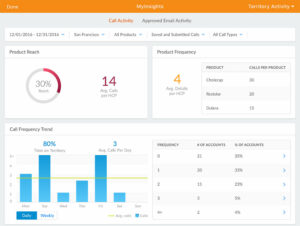How to improve the impact of your Veeva MyInsights
One of the very first questions our customers have when it comes to MyInsights is how to fully leverage the strengths of MyInsights reporting capabilities. This is a difficult question as this tool it’s anything but a one-size-fits-all solution. By calling upon our previous experience and expertise, we’ve tried to identify blockages or constrains that might undermine the full potential and thus the business value of MyInsights reporting.
This blog explains some of our findings.
It’s doesn’t stop with a different visualization of your data. MyInsights is ‘a powerful and innovative data visualization tool’. But a lot of our customers chose to use it for an alternative (perhaps fancier), representation of the same data. A bit like ‘same meat, different gravy’ kind of thing.
MyInsights has a lot more to offer. It should allow you to solve business cases, provide calls-to–action and make life easier for your users. For instance, you can focus on visualizing which visits have been done and how well you perform versus your (multi-channel) cycle plan. But shouldn’t you (also) concentrate on the visits not performed, or on customers not visited frequently enough? Why not have MyInsights suggest what you need to discuss and the contacts you need to get in touch with? Why not leverage the technology to improve your customer engagement?
Who are you trying to help? The MyInsights dashboards should be the result of an exercise in working with people. But the people you are working with have a wide variety of perspectives and different needs when it comes to their view on the what and how it should be done.
Internal stakeholders with their valuable and in-depth of the business knowledge, are usually not the ultimate beneficiary of MyInsights dashboards. The reports are designed for your end-users, and it is in their minds that you need to deep-dive. Not involving the end users in the creation process, not fully understanding their needs, frustrations and objectives will undermine the success of the project. It is the end users that must first be convinced of the value before they can become true ambassadors of the services you’ve just delivered.
A successful exercise continues after each launch. Consider it a ‘lean’ release of an internal iterative product development: experiment, improve, repeat. Set a path to maturity. As business and customer needs change, the dashboards might also change. They must be continuously refined to serve the targeted audience and enable sound decisions. Validate your roadmap by carefully listening to your users and their experience.
Co-Create. We are often asked about the most impactful business cases. It’s a very tricky question. The best way to ensure that your business case has a maximum impact within your organization is by involving different groups in the co-creation of such projects. Dare to gamify the process: ask your teams to push forward different ideas and introduce game mechanics such as rules, challenges and rewards for achievements. You don’t only increase the fun factor in this idea’s generator, but most importantly you motivate and engage your team.
Experiment. Challenge the status quo. MyInsights is a visualization layer, but it is based on modern website technology: it allows you to use any webservice available. Leverage this. Do you want to visualize something – not available in Veeva? Why not power up a webservice and show it within the application? Do you want to create a PowerPoint from MyInsights? Why not leverage Amazon Webservices? Do not be afraid to experiment, and do not be afraid to fail. But fail fast (& cheap) and learn quickly.
It is all about the experience: the Customer Experience. We started – as many – with developing MyInsights pages from a CRM perspective. But in the meanwhile, our focus has shifted on the User experience (UX). You need a deep understanding of your users, their needs, what they value and what frustrates them. Is the information flow correct, is the most important information available in the right place, are the fonts of the correct size? The devil is in the details.
When designing your reports, take your users’ emotions and attitudes into account. They will determine if they feel happy with your work. User experience is not to be confused with usability, though. It’s more than this. It includes the practical, the experiential and the meaningful and it defines if it resonates with the users. We’ve solved this by leveraging a UI/UX specialist in the creation process. These are specialized but unmistakable skills. Make sure to add them to your team, as designing for a great experience is the best way to gain the trust and loyalty of your users.
